In science fiction canon, big-scale far-future stories usually get all the glory. Books set on other worlds, with space ships and alien encounters are what many people think SF is all about. And those books are great. I love space opera, and I love far-future SF books like Dune or the Culture books by Iain Banks, or Peter F. Hamilton’s crack-o-liciously good duology of Pandora’s Star/Judas Unchained. But there is something equally appealing about near-future SF stories.
Instead of focusing on huge galaxy-spanning conflict, near-future SF keeps things local; earth-bound. The reason I find these stories interesting is that they are a way to look at our own society and technology, only a step into the future. The best books are extrapolations of current technologies and situations that seem like maybe they might already be possible. In some near-future SF the technological revolution is just starting. In others it is well underway. But there are those who remember the way it used to be, in generations not so distant. Maybe their granny lived a different way. The struggle isn’t against an alien menace, it’s against ourselves and the technology we bring into the world and the way that technology sometimes outstrips our ability as a society to cope with change.
Some near-future SF is all about catastrophe, but I lump apocalyptic and post-apocalyptic stories in a different bin and I’ve talked that subgenre before. There are lots of authors out there proving that you need to have an apocalypse to get a grim near future. Sometimes it is more interesting when the changes creep up more slowly, without a disaster to spur them along. The near future is just where we’re already heading, with shinier toys. I like that it is still easy to recognize the world as our own.
The danger of near-future SF can be that a few years after they are written, the world they described so interestingly might have gone a completely different direction, making the narrative seem like a quaint dead-end. It’s risky, betting on what’s going to happen tomorrow. Much riskier than spinning fancies of what will happen 1000 years from now. But I salute authors who take the risk.
Some of my favorite near-future SF, grouped by the tech advances at their hearts:
DRUGS
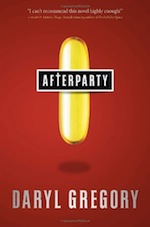 Afterparty
Afterparty by Daryl Gregory
I read three books by Gregory in 2014 (including We Are All Completely Fine and its forthcoming prequel Harrison Squared, both marvelous), but this is a book that blew me away when I read it and stuck with me after. The technology being explored and extrapolated in Gregory’s near-future is pharmaceutical in nature. The completely inevitable-seeming development of 3-D printing into the sphere of drug manufacturing means that small niche drugs can be developed and printed by anyone with a chemjet and a recipe. From this plausible premise Gregory spins a addictively (sorry) entertaining thriller involving Lyda Rose, a woman who was part of a small company which developed a dangerous drug. All involved vowed to never allow the drug to be made, but when Lyda discovers that someone is making the drug, she breaks out of a mental hospital to stop them.
 Nexus
Nexus by Ramez Naam
The combination of nanotechnology and pharmaceuticals seems like an inevitability, explored by Ramez Naam quite cleverly his first novel, Nexus. His hero is grad student Kade Lane, who has been tinkering with Nexus, a nanotech delivery system that he has figured out how to use to allow mind-to-mind communication. The government wants in on that, unfortunately, and blackmails Kade into tracking down a Chinese researcher who plans to use Nexus for a mind-control program. This is a tense, fast-paced technothriller that continues in Crux and the delayed final (I think) volume Apex.
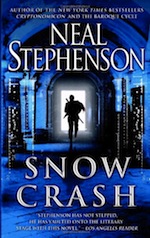 Snow Crash
Snow Crash by Neal Stephenson
Hiro Protagonist is a delivery guy for a mafia-run pizzeria, but in the Metaverse, he’s a fierce warrior and a prince. So naturally he spends a lot of time in the game. When a fellow gamer warns him about a street drug called “Snow Crash”, Hiro gets pulled into a crazy conspiracy that somehow involves pharmaceuticals, ancient Sumeria and computer viruses. Both laugh-out-loud funny and bitingly cynical, Stephenson extended the lifespan of cyberpunk. This is a truly groundbreaking work of near-future SF, that also happens to be a lot of fun. It’s hard to believe this was written way back in 1992, as it seems fresh and relevant, even today.
GENETIC ENGINEERING
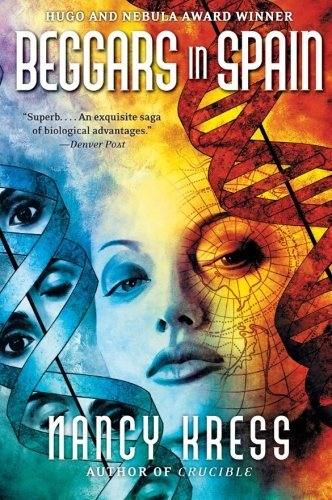 Beggars in Spain
Beggars in Spain by Nancy Kress
What if scientists had discovered a way to genetically modify people to not need sleep? Leisha Camden was one of the first batch to undergo the treatment, and what was one seen as a potentially revolutionary/evolutionary leap has become anathema to society, the “Sleepless” shunned outcasts. Most of the Sleepless leave the earth for an orbital platform, but Leisha stays behind to try to advocate for tolerance. This was a fascinating novella (it won the Hugo AND the Nebula) that works really well in expanded form as a novel. The genetic engineering for the Sleepless is just one of the interesting developments in genetic modification, and Kress also throws in cold fusion energy in her future. From small questions of “what would it be like to not need sleep?” to bigger questions about how society would react to what is – in effect – a new strain of human beings, this is a book that I immediately wanted to talk to someone else about.
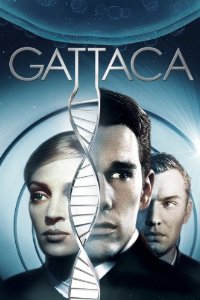 Gattaca
Gattaca
I have a deep and enduring love for this 1997 movie. It depicts a future that may not be as “near” as some of the things on this list, but still close enough that not everyone has benefitted from the advanced of technology that abounds. In this future, society embraced eugenics – genetic manipulation to ensure only the best qualities of both parents are passed on. Vincent Freeman is an “invalid” – not engineered and full of the small flaws that have been weeded out of the gene pool. He’s a second-class citizen, fit only for menial work because of his genome. Vincent desperately wants to work at Gattaca, a tech company working on a mission to Saturn’s moon Titan. He finds an accomplice in Jerome, a wheelchair-bound “valid” who agrees to let Vincent borrow his genetic material to pass the screening measures at Gattaca. With Ethan Hawke, Jude Law and Uma Thurman, this is a super-stylish, tense SF thriller.
VIRTUAL REALITY / GAMING
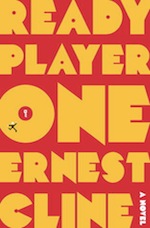 Ready Player One
Ready Player One by Ernest Cline
One of the most engaging and entertaining near-futures I’ve read in years, this book is aimed squarely at my own generation, Gen X. The premise is that in the year 2044, the world is obsessed with an immersive virtual reality game/world called Oasis. It’s a dystopian future, and our hero Wade Watts is a teenager who lives in the “stacks” (a kind of vertical trailer park) and spends his time looking for easter eggs in the Oasis game. The billionaire who created the game, James Halliday hid clues to a lottery ticket – one that will reward the finder with both riches and control of Oasis itself. The puzzles that seekers like Wade will need to solve are based on Halliday’s love of all pop culture from the 1980s – TV, arcade games, movies, etc. If you grew up in the 1980s, this will ring all your bells and make you nostalgic as hell. Wade, of course, is one of the first in years to solve one of the puzzles, and after that the race is on! It’s high adventure, and so much fun.
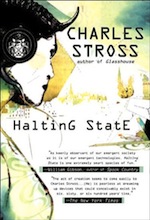 Halting State
Halting State by Charles Stross
Another book that looks at MMORPGs in the future – in this case just a tiny step into the future – is this books from the marvelous Charles Stross. I adore his Lovecraftian/Spy novels in the Laundry Files series, but he has also been writing books set in his native Edinburgh that combine crime fiction and near-future SF. A local cop, an insurance accountant, and a computer programmer are all investigating a massive theft. Real-world and virtual worlds collide as a bank heist in a game world has real life consequences. Stross is so smart about the little details of his near-future – everything seems so plausible that you wonder if it doesn’t already exist. It’s a geeky crime thriller for tech heads, and I enjoyed it immensely. The follow-up (but not sequel) Rule 34 is equally awesome. I hope Stross returns to near-future Edinburgh soon.
CORPORATE FUTURESCAPE / ADVERTISING / MARKETING
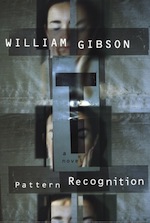 Pattern Recognition
Pattern Recognition by William Gibson
Is this even the future? Or is it the present that just feels like the future. I could have picked Neuromancer for my Gibson pick, or even his recent (and MARVELOUS) combo of near-future and farther-future The Peripheral
. But I really loved Pattern Recognition and the rest of the Blue Ant trilogy for how it took technologies we already have and made them seem futuristic and new. This first volume introduces Cayce Pollard, a trend spotter (known as a “cool hunter”) who crosses paths with millionaire Hubertus Bigend. Bigend hires her to find the origin of a mysterious series of film clips; a job that takes her around the world and into some of its dark corners. It works as an engaging thriller, but it is always Gibson’s trenchant observations about tech and society that keep me coming back. The series continues with Spook Country and Zero History.
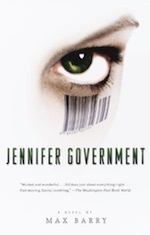 Jennifer Government
Jennifer Government by Max Barry
Max Barry has a beautifully bizarre imagination, which he can wed to perfectly crafted thrillers. Although I was absolutely blown away by his recent thriller Lexicon, Jennifer Government was the first book of his that I read. It is cynical, clever, over-the-top, funny, tense and wildly satirical. The medium-future of Barry’s novel is one where many world governments have collapsed and corporations have filled the vacuum. People take the last name of the company they work for. Hack Nike is an employee of the shoe company ( I do not know how Barry got away with that or his other company placements, BTW) who gets talked into a criminal act in order to drum up a marketing frenzy for the company’s new shoe. Luckily Jennifer Government is on the case. I love Jennifer, a tough single mother who is used to be an ad exec before turning to law enforcement. Barry’s future is wildly inventive, but somehow plausible. It’s a fast, fun read that didn’t get the exposure it should have when it came out.
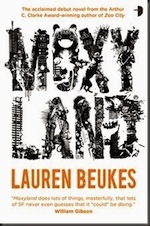 Moxyland
Moxyland by Lauren Beukes
I have always been wowed by Lauren Beukes, and even this, her first novel, is amazing. It follows four young people in a near-future Capetown, South Africa. In her future, people are pretty much ruled by their cell phones (already true) ad corporations have immense power. People who commit a crime can be “disconnected”, having their cell phone SIMS blocked and leaving them cut off from society. One character is an activist protesting the power of the government and corporations over people through their SIMS, but another is broke so she lets a corporation “sponsor” her – injecting her with nanobots which are supposed to give her special abilities but which come with a cost. It is especially impressive as a first novel. Beukes just gets better and better.
SPECIAL MENTION:
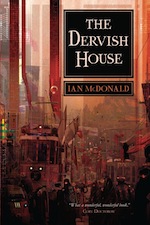 The Dervish House
The Dervish House by Ian McDonald
Ian McDonald books are not easy, gentle reads. He throws you into the deep end and lets you flounder for a while, but I think he’s brilliant. In near-future set books like Dervish House and Brasyl and The River of Gods, he takes exotic settings, cyberpunk sensibilities, and a touch of mysticism to forge complex, fascinating future worlds. Set in 2027 Istanbul, The Dervish House kicks off with a suicide bombing on a tram. This act sets ripple in motion that affect the lives of several residents of a nearby apartment building that was once a Dervish House, home to Sufi mystics. Although it is an act of terrorism that sets things in motion, McDonald looks at many other near-future tech developments, especially artificial intelligence. He’s a gorgeous writer. I end up reading his books slowly just to savor his prose and the intricate world on the page.
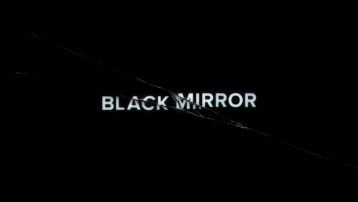 Black Mirror: Complete Series 1
Black Mirror: Complete Series 1
This British series has been compared to The Twilight Zone, and it’s not a stretch. Like many of the best episodes of The Twilight Zone, Black Mirror looks at the technologies we use and how they may progress in the near future. And also like the Twilight Zone, this stuff is dark. Cynical doesn’t even begin to cover it. The series skewers social media, especially, but all the technology we use and love seems like fodder for creator Charlie Brooker. My favorite so far was the second episode “Fifteen Million Merits”, which looks at fame and reality TV. So far it is only two seasons of three episodes each (damn you Brits and your short TV seasons!!), plus a Christmas special so dark that they aired it a few weeks before the holiday so as not to depress the nation. If you have Netflix, you should check it out.